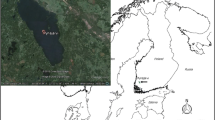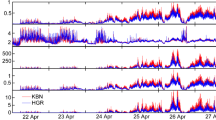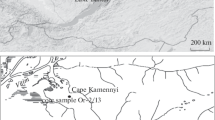Abstract
The eutrophicated Enäjärvi was studied by paleolimnological analyses and sediment mapping. The sedimentary record indicates that the lake nutrient balance had deteriorated due to lowering of the lake water level in the year 1928. From that event onwards Chironomus plumosus and Cyclotella astraea characterize the chironomid and diatom communities. The concentrations of sedimentary total and mobile phosphorus show that since then the internal load of phosphorus has controlled the nutrient cycle of the lake. The areal distribution of mobile phosphorus can be explained by dominant wind directions and wind resuspension of the sediment is the key factor in the nutrient cycle. Restoration of Enäjärvi must be based on actions which stabilize the surface sediment and improve its natural phosphorus-binding capacity. They include the regulation of lake water to as high a level as possible and the removal of the majority of roach.
Similar content being viewed by others
References
Alhonen, P., 1967. Palaeolimnological investigations of three inland lakes in southwestern Finland. Acta Bot. Fennica 76, 59 pp.
Alhonen, P., 1972. Gallträsket: The geological development and palaeolimnology of a small polluted lake in Southern Finland. Comment. Biol. 57, 34 pp.
Alhonen, P., 1979. The sedimentary record of the cultural eutrophication and pollution of lakes in Finland. Arch. Hydrobiol. 86: 13–26.
Alhonen, P., 1981. Stratigraphical studies on Lake Iidesjärvi sediments. Part 1. Environmental changes and palaeolimnological development. Bull. Geol. Soc. Finland 53: 97–107.
Alhonen, P., 1982. Diatoms in the sediments of Lake Enäjärvi (S. Finland) as indicators of its trophic history. A preliminary note. In, Physical, chemical and biological dynamics in sediment, Proc. of the 10th Nordic symp. on sediment, Division of Water Engineering, Helsinki University of Technology, Report 26: 219–223.
Alhonen, P., 1983. Applied palaeolimnology: sediment stratigraphical information for lake modelling. IPPCCE Newsletter 1983: 8–12.
Alhonen, P., 1985. Lake restoration: a sediment limnological approach. Aqua Fennica 15: 269–273.
Alhonen, P. & S. Mantere-Alhonen, 1988. Seasonal variation in the phytoplankton composition and biomass of two hypereutrophic lakes in southern Finland. Memoranda Soc. Fauna Flora Fennica 64: 57–64.
Andersen, J. M., H. Liiv, A. Heinsalu, J. Windolf, M. Søndergaard & A. Tuvikene, 1992. Harku järv lake restoration. Aarhus county, technical report, 95 pp.
Bengtsson, L. & M. Enell, 1990. Chemical analysis. In B. E. Berglund (ed.), Handbook of Holocene palaeoecology and palaeohydrology. J. Wiley & Sons, New York: 423–448.
Boström, B., 1984. Potential mobility of phosphorus in different types of lake sediment. Int. Revue ges. Hydrobiol. 69: 457–474.
Boström, B., I. Ahlgren & B. Russell, 1985. Internal nutrient loading in a eutrophic lake, reflected in seasonal variations of some sediment parameters. Verh. int. ver. Limnol. 22: 3335–3339.
Boström, B., M. Jansson & C. Forsberg, 1982. Phosphorus release from lake sediments. Arch. Hydrobiol. Beih. Ergebn. Limnol. 18: 5–59.
Boström, B., J. M. Andersen, S. Fleischer & M. Jansson, 1988. Exchange of phosphorus across the sediment-water interface. Hydrobiologia 170: 229–244.
Brodin, Y., 1982. Palaeoecological studies of the recent development of the Lake Växjösjöm, IV. Interpretation of the eutrophication process through the analysis of subfossil chironomids. Arch. Hydrobiol. 93: 313–326.
Brugam, R. B., 1983. The relationship between fossil diatom assemblages and limnological conditions. Hydrobiologia 98: 223–235.
Cato, I., 1977. Recent sedimentological and geochemical conditions and pollution problems in two marine areas in south-western Sweden. Striae 6, 158 pp.
Dévai, G. & J. Moldován, 1983. An attempt to trace eutrophication in a shallow lake (Balaton, Hungary) using chironomids. Hydrobiologia 103: 169–175.
Forsberg, C., 1989. Importance of sediments in understanding nutrient cyclings in lakes. Hydrobiologia 176/177: 263–277.
Granéli, W., 1979. The influence of Chironomus plumosus larvae on the oxygen uptake of sediment. Arch. Hydrobiol. 87: 385–403.
Hamilton, A. L. & O. A. Saether, 1971. The occurrence of characteristic deformities in the Chironomid larvae of several Canadian lakes. Can. Ent. 103: 363–368.
Hartikainen, H., 1979. Phosphorus and its reactions in terrestrial soils and lake sediments. J. Scient. Agric. Soc. Finl. 51: 537–624.
Haworth, E. Y., 1972. The recent diatom history of Loch Leven, Kinross. Freshwat. Biol. 2: 131–141.
Heinonen, P., 1980. Quantity and composition of phytoplankton in Finnish inland waters. Publ. Water Res. Inst. (Nat. Board Waters, Finland) 37, 91 pp.
Hindersson, R., 1933. Förgiftning av nötkreatur genom sötvattensplankton. Finsk. Vet. Tidskrift 39: 179–189. (In Swedish)
Hofmann, W., 1971. Zur Taxonomie und Palökologie subfossil Chironomiden (Dipt.) in Seesedimenten. Arch. Hydrobiol./Beig. Ergebn. Limnol. 6: 1–50.
Hofmann, W., 1986. Chironomid analysis. In B. E. Berglund (ed.), Handbook of Holocene palaeoecology and palaeohydrology. J. Wiley & Sons, New York: 715–727.
Hofmann, W., 1988. The significance of chironomid analysis (Insecta: Diptera) for paleolimnological research. Palaeogeogr., Palaeoclimatol., Palaeoecol. 62: 501–509.
Hutchinson, G. E., 1967. A Treatise on Limnology, 2. Introduction to lake biology and the limnoplankton. J. Wiley & Sons, New York, 1115 pp.
Kauppi, M., T. Kylä-Harakka, P. Nieminen & K. Pihala, 1977. Kuormituksen vähentämisen vaikutuksista Enäjärvessä, Ohjattu järvitutkimus 1977. Helsingin yliopisto, Limnologian laitos, Helsinki, 24 pp. (In Finnish)
Kauppi, L., O. Sandman, S. Knuutila, K. Eskonen, A. Liehu, S. Luokkanen & M. Niemi, 1990. Maankäytön merkitys vesien käytölle haitallisten sinileväkukintojen esiintymisessä. Vesi-ja ympäristöhallinnon julkaisuja, Sarja A, 48, 55 pp. (In Finnish)
Karonen, M., 1978. Matemaattisten vedenlaatumallien soveltaminen vesistösuunnitteluun. Diplomityö. Teknillinen korkeakoulu, Espoo, 165 pp. (In Finnish)
Kettunen, J., 1980. Ravinteiden kierto matalassa eutrofisessa järvessä-sovellutuskohteena Vihdin Enäjärvi. Teknillinen korkeakoulu, Vesitekniikan laitos, Julkaisu 20, 155 pp. (In Finnish)
Kettunen, J., 1981. Model for a eutrophic finnish lake — a case study. Aqua Fennica 11: 49–54.
Kettunen, J. & M. Stenmark, 1982. Wind induced resuspension and phosphorus exchange between resuspended sediment and lake water. In, Physical, chemical and biological dynamics in sediment, Proc. of the 10th Nordic symp. on sediment, Division of Water Engineering, Helsinki University of Technology, Report 26: 11–20.
Kettunen, J., K. Lindberg & M. Stenmark, 1982. Sediment submodel — a case study of Lake Enäjärvi, southern Finland. Nordic expert meeting on water quality models in water management, Hanasaari cultural centre, Nov. 9–11, 1981, Proceedings of the meeting: 117–128.
Kukkonen, E., 1973. Sedimentation and typological development in the basin of the Lake Lohjanjärvi, South Finland. Geol. Surv. Finland, Bull. 261, 67 pp.
Kukkonen, E. & R. Tynni, 1970. Die Entwicklund des Sees Pyhäjärvi in Südfinnland im Lichte von Sediment- und Diatomeenuntersuchungen. Acta Bot. Fennica 90, 30 pp.
Lepistö, L., 1988. Some centric diatoms as indicators of water quality in Finnish lakes. 10th Diatom-symposium 1988: 499–504.
Mölder, K. & R. Tynni, 1967. Über Finnlands rezente und subfossile Diatomeen, 1. C. r. Soc. géol. Finlande 39: 199–217.
Rekolainen, S., L. Kauppi & E. Turtola (eds), 1992. Maatalous ja vesien tila. Maveron loppuraportti. Maa- ja metsätalousministeriö, Luonnonvarainneuvosto, Luonnonvarajulkaisuja 15, 61 pp. (In Finnish, English summary)
Räsänen, M., V.-P. Salonen, J. Salo, M. Walls & J. Sarvala, 1992. Recent history of sedimentation and biotic communities in Lake Pyhäjärvi, SW Finland. J. Paleolimnol. 7: 107–126.
Salonen, V-P. & A. Itkonen, 1992. Vihdin Enäjärven ja Säkylän Pyhäjärven sedimentit sekä niistä aiheutuva sisäinen fosforikuorma. Geological Survey of Finland, Open File Report P 36.4.001, 33 pp. (in Finnish)
Sarvala, J., 1992. Trends in Finnish limnology during 1940–1989. Hydrobiologia 243/244: 1–19.
Seppänen, H. & S. Rusi, 1983. Kasvi- ja eläinplanktonin vuotuinen sukkessio Vihdin Enäjärvessä. Vesitalous 1983: 7–9. (in Finnish)
Søndergaard, M., 1988. Seasonal Variations in the loosely sorbed phosphorus fraction of the sediment of a shallow and hypereutrophic lake. Envir. Geol. Water Sci. 11: 115–121.
Tolonen, K., V. Ilmavirta, H. Hartikainen & J. Suksi, 1990. Palaeolimnological investigation of the eutrophication history of Lake Tuusulanjärvi, southern Finland. Aqua Fennica 20: 27–41.
Vuorinen, A., P. Alhonen & J. Suksi, 1986. Palaeolimnological and limnogeochemical features in the sedimentary record of the polluted Lake Lippajärvi in southern Finland. Environ. Pollut. Ser. A 41: 323–362.
Walker, I. R., 1987. Chironomidae (Diptera) in palaeoecology. Quat. Sci. Rev. 6: 29–40.
Walker, I. R., C. H. Fernando & C. G. Paterson, 1984. The chironomid fauna of four shallow, humic lakes and their representation by subfossil assemblages in the surficial sediments. Hydrobiologia 112: 61–67.
Walker, I. R. & C. G. Paterson, 1985. Efficient separation of subfossil Chironomidae from lake sediments. Hydrobiologia 122: 189–192.
Warwick, W. F., 1990. Morphological deformities in Chironomidae (Diptera) larvae from the Lac St. Louis and Laprairie basins of the St. Lawrence river. J. Great Lakes Res. 16: 185–208.
Wiederholm, T. (ed.), 1983. Chironomidae of the Holarctic region. Keys and diagnoses. Part 1 — Larvae. Ent. Scand. Suppl. 19: 1–457.
Wiederholm, T., 1984. Incidence of deformed chironomid larvae (Diptera: Chironomidae) in Swedish lakes. Hydrobiologia 109: 243–249.
Wiederholm, T. & L. Eriksson, 1979. Subfossil chironomids as evidence of eutrophication in Ekoln Bay, Central Sweden. Hydrobiologia 62: 195–208.
Author information
Authors and Affiliations
Rights and permissions
About this article
Cite this article
Salonen, VP., Alhonen, P., Itkonen, A. et al. The trophic history of Enäjärvi, SW Finland, with special reference to its restoration problems. Hydrobiologia 268, 147–162 (1993). https://doi.org/10.1007/BF00014050
Received:
Revised:
Accepted:
Issue Date:
DOI: https://doi.org/10.1007/BF00014050




